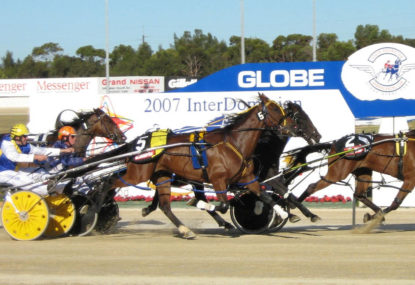TWO GOOD! Zahra wins back-to-back Melbourne Cups on Without a Fight as three horses pull up lame
Without a Fight completed the rare Caulfield Cup-Melbourne Cup double on Tuesday as star jockey Mark Zahra went back-to-back in the big one after…

Absence, we are reliably informed, makes the heart go fonder. Unfortunately, it can also make you irrelevant, which is what many of harness racing’s best horses are going to be for the next six to eight months.
Just days after a blistering Miracle Mile at Menangle saw Lennytheshark down Smolda and Lazarus in front of over 10,000 people, the party is over.
At a time when punters may have watched and thought the gladiators of pacing were a competitive antidote to the amazing but rather repetitive domination of galloping great Winx, we now won’t see them all together again until next season.
For those who haven’t been paying attention, the harness racing season reached its crescendo in the $750,000 Miracle Mile on the outskirts of Sydney on February 25.
The race lived up to its 50th birthday party, with a dazzling early section followed by home straight drama, with four different horses looking the winner.
It was racing at his best and even those who look down the noses at harness racing, the laid-back cousin to the hyperbole of the galloping industry, had to admit it was pretty special.
But the problem is after their first real meeting for the season, the big guns of harness racing now all get aimed at different targets. Or nothing at all.
Harness horses are stronger and more durable than their galloping relatives and should race more often. But it seems they don’t these days. Well, not against each other any way.
Changes in the racing calendar mean what used to be the season-ending finale of the Inter Dominions now starts in November, when younger superstars like Lazarus aren’t mature enough to race four times in a fortnight. And it also comes straight after the iconic New Zealand Cup.
Being in Perth, it attracts half the pacing elite, maybe a few more.
Then the big-time horses get set for the Summer of Glory carnival in Victoria, where we should see them go to war in the Ballarat, Victoria and Hunter Cups.
But we don’t.
Their trainers pick and choose, with the difference in stake money not overly great, and we never got to see the best clash with each other because they don’t have to, the incentive is not there.
So by the time we got to the season’s zenith at Menangle, the absolute stars of the game – Lazarus, Lennytheshark, Smolda, Hectorjayjay, Waikiki Beach and Bling It On – had never been in the same race.
In fact, there hadn’t been one race all season in which more than three of them started. So as wonderful as the Miracle Mile was, it was like round one of the footy finals being followed by no more footy.
Some of the big names will press on deeper into the season but they will only rarely race each other, instead picking off the low-hanging fruit on the country cups circuit or in age group racing.
And harness racing loses a golden opportunity.
Because the horses are tougher and handle travel better, they should be racing each other at least five, maybe even eight times a year. That would give the industry some momentum, some name recognition for the media, and a point of difference from the sometimes-protected world of big-galloping action, where stud careers can outweigh racetrack value.
Ironically, because Winx is a mare and arch rival Hartnell a gelding, we get to see them clash up to six times a season.
Australian harness racing actually has a thing called the Grand Circuit, which is supposed to bring these horses together all over the country but it simply doesn’t work.
The main reason is money.
The Inter Dominion is $1.1 million, the Miracle Mile $750,000 and the New Zealand Cup $NZ800,000.
So they are the be-all, end-all targets to the point where the $500,000 of the Hunter Cup can sometimes be canablised by the $400,000 Victoria Cup a week earlier. They are simply too interchangeable.
And Australian officials fear the AFL and NRL so much, they try and squeeze their entire feature-race season into just over four months, meaning the elite horses can’t and don’t fit it all in.
This, sadly, leaves eight months in which the stars never come out at the same time.
In the modern world, where attention spans are measured in download speeds, harness racing’s elite needs to race each other more often and for longer.
Because absence makes the heart grow fonder for a while. Then people, particularly punters, just move on.